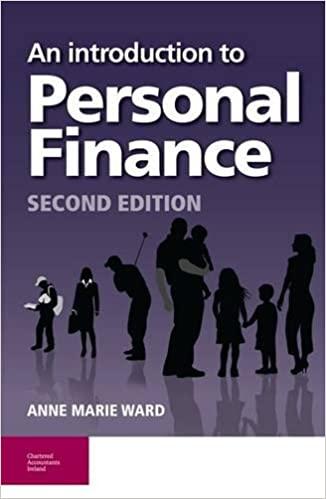Question
Find the PV of an ordinary annuity that pays $1,000 each of the next 6 years if the interest rate is 13%. Then find the
Find the PV of an ordinary annuity that pays $1,000 each of the next 6 years if the interest rate is 13%. Then find the FV of that same annuity. Round your answers to the nearest cent.
PV of ordinary annuity: $ fill in the blank 25 FV of ordinary annuity: $ fill in the blank 26
g. How will the PV and FV of the annuity in part f change if it is an annuity due rather than an ordinary annuity? Round your answers to the nearest cent.
PV of annuity due: $ fill in the blank 27 FV of annuity due: $ fill in the blank 28
h. What will the FV and the PV for parts a and c be if the interest rate is 10% with semiannual compounding rather than 10% with annual compounding? Round your answers to the nearest cent.
FV with semiannual compounding: $ fill in the blank 29 PV with semiannual compounding: $ fill in the blank 30
i. Find the annual payments for an ordinary annuity and an annuity due for 12 years with a PV of $1,000 and an interest rate of 9%. Round your answers to the nearest cent.
| Annual payment for ordinary annuity: | $ fill in the blank 31 |
| Annual payment for annuity due: | $ fill in the blank 32 |
j. Find the PV and the FV of an investment that makes the following end-of-year payments. The interest rate is 9%.
| Year | Payment |
| 1 | $200 |
| 2 | $300 |
| 3 | $500 |
Round your answers to the nearest cent.
PV of investment: $ fill in the blank 33 FV of investment: $ fill in the blank 34
k. Five banks offer nominal rates of 7% on deposits, but A pays interest annually, B pays semiannually, C pays quarterly, D pays monthly, and E pays daily. Assume 365 days in a year.
What effective annual rate does each bank pay? If you deposit $6,000 in each bank today, how much will you have in each bank at the end of 1 year? 2 years? Round your answers to two decimal places.
| A | B | C | D | E | ||||||
| EAR | fill in the blank 35 | % | fill in the blank 36 | % | fill in the blank 37 | % | fill in the blank 38 | % | fill in the blank 39 | % |
| FV after 1 year | $ fill in the blank 40 | $ fill in the blank 41 | $ fill in the blank 42 | $ fill in the blank 43 | $ fill in the blank 44 | |||||
| FV after 2 years | $ fill in the blank 45 | $ fill in the blank 46 | $ fill in the blank 47 | $ fill in the blank 48 | $ fill in the blank 49 | |||||
If the TVM is the only consideration, what nominal rate will cause all of the banks to provide the same effective annual rate as Bank A? Round your answers to two decimal places.
| B | C | D | E | |||||
| Nominal rate | fill in the blank 50 | % | fill in the blank 51 | % | fill in the blank 52 | % | fill in the blank 53 | % |
Suppose you don't have the $6,000 but need it at the end of 1 year. You plan to make a series of deposits annually for A, semiannually for B, quarterly for C, monthly for D, and daily for E with payments beginning today. How large must the payments be to each bank? Round your answers to the nearest cent.
| A | B | C | D | E | ||||||
| Payment | $ fill in the blank 54 | $ fill in the blank 55 | $ fill in the blank 56 | $ fill in the blank 57 | $ fill in the blank 58 | |||||
Step by Step Solution
There are 3 Steps involved in it
Step: 1

Get Instant Access to Expert-Tailored Solutions
See step-by-step solutions with expert insights and AI powered tools for academic success
Step: 2

Step: 3

Ace Your Homework with AI
Get the answers you need in no time with our AI-driven, step-by-step assistance
Get Started


